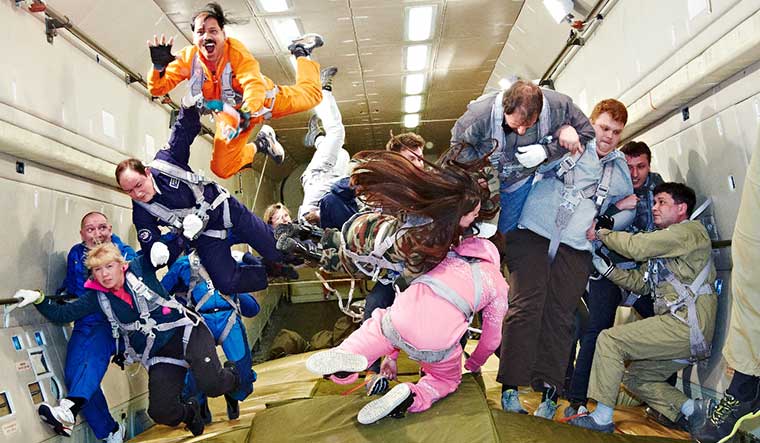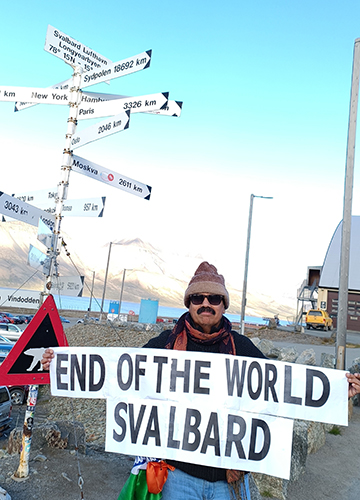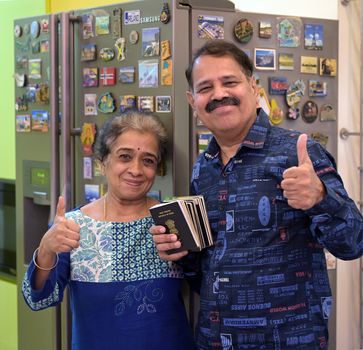He gazed out at the curvature of the earth. Below him was what looked like a blue fog covering the surface of the earth. Above him, the dark sky was sprinkled with stars, in the middle of the day. A short while ago, he had been in Russia. Now, he was in the stratosphere.
As India celebrated its 68th Independence Day, an Indian was getting into the back seat of a MiG-29. At 11:30am, local time, the fighter jet carrying T.N. Suresh Kumar took off from the Sokol airbase in Nizhny Novgorod. Land fell away rapidly. Kumar was mesmerised, taking in every second of the awe-inspiring experience. Soon, the jet was shooting through the sky at a speed of around 2,000kmph (Mach 1.7). And Kumar, even in a G-suit, felt the staggering force of 7G―gravity pulling him back to earth with a force seven times his body weight. But, no force could break his will. For he had dreamed about this for too long.
It was in 2006 that Kumar, an Indian Space Research Organisation scientist, first heard about the edge-of-space flight in Russia being offered to civilians. The MiG could go as high as 20km-22km, depending on weather and temperature, but, 17km was guaranteed. Technically, that is a flight to the stratosphere (approximately 12km-50km above the earth’s surface). The delineation used by most scientists for the edge of space―the Karman line―is 100km above the earth’s surface. However, only astronauts and cosmonauts had ever gone higher than the Russian edge-of-space flights which were taking tourists.
When he heard about the opportunity, Kumar had just returned from Antarctica. But, he jumped upon the chance and made inquiries in Russia. The excitement though was shortlived―the experience would cost Rs47 lakh. He could not afford it.
Kumar had cherished a lifelong aspiration to behold the earth from the vantage point of space. In fact, he came close to getting on a flight to space―ISRO had planned a manned mission to space in the mid-1980s, in collaboration with NASA. Kumar signed up for selection and made it to the final four from 800-odd aspirants. But, after NASA’s Challenger broke apart killing all seven crew members, the ISRO mission was called off.
Two decades later, it seemed like Kumar’s hope of reaching at least the stratosphere had been crushed by the cost. But, space-related tourism grew fast and the costs came down. And, at long last, he made the trip in 2014, becoming the first Indian to do so. He shelled out Rs15 lakh and chose August 15 for the flight.
However, the trip was by no means as easy as paying the fee and choosing a date. “It required lot of documentation and paper work, clearance from ISRO and the Russian embassy,” Kumar told THE WEEK. “The procedure took six months, including pre-flight training.” Kumar lost his mother around two months before the flight. He put in a request seeking permission to carry his mother’s photograph during the flight, along with the Indian flag. His chosen date and requests were approved.
Kumar had undergone a few medical tests in India. But, when he reached Russia, he had to repeat many of them. Apart from physical and mental fitness, those aspiring to be on the flight must also have basic aerospace knowledge. The aspirants’ height must not be more than 6’5”, as that may lead to their head hitting the canopy of the cockpit during in-flight manoeuvres. They also should not have spinal and cardiac problems or prior surgeries. “People who do not qualify are sent back,” said Kumar, who had to sign an indemnity bond before the flight.
After the medical tests and documentation, Kumar was introduced to the pilot Sergei Sara, who gave him additional training for around five days. As Kumar was not a fighter pilot, the focus was on how to eject in case of an emergency. “One has to get adjusted to the Mach speed of the aircraft,” said Kumar. “During the flight, the pilot is always mindful of the tourist’s safety.” He said the flight was one of greatest experiences of his life. “At 10,000 metres, the pilot even allowed me to manoeuvre the MiG-29 and after returning to the troposphere, we did many manoeuvres such as rolls, inverted flight and nose down,” said Kumar, excited at the memory. The flight lasted 48 minutes from take-off to landing.
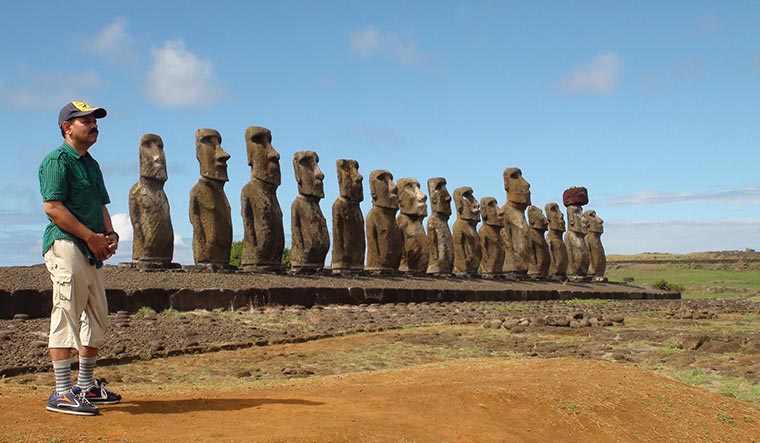 At Easter Island, where he said he was the first Indian to visit.
At Easter Island, where he said he was the first Indian to visit.
Six months after the flight to the stratosphere, he came to know of the zero-gravity flight, which was being offered from the Yuri Gagarin Cosmonaut Centre in Moscow. The cost was around Rs6 lakh. The flight, called Aerolab, used the 46.59m-long Il-76 MDK aircraft. During the flight, the interiors simulated zero-gravity conditions. This was done by flying to a height of around 9,000m and then curving downward. The tourists would feel weightlessness at the upper point of the parabola. This state would last up to 30 seconds and could be recreated 15 times in one flight of around one-and-a-half hours. So, of the total 5,400 seconds, zero gravity could be experienced for about 450 seconds. The interiors were padded to protect the floating tourists.
Kumar said when he went on the zero-gravity flight, it had 15 people from various countries. “I was the only Indian on board,” he said. “One doctor was also with us. People started doing different things; one person did yoga. But, many people started experiencing nausea and vomiting. With change in gravity, the body experiences a lot of changes like dehydration. Before the flight, the Russian team had explained about the manoeuvres and the changes the body experiences.”
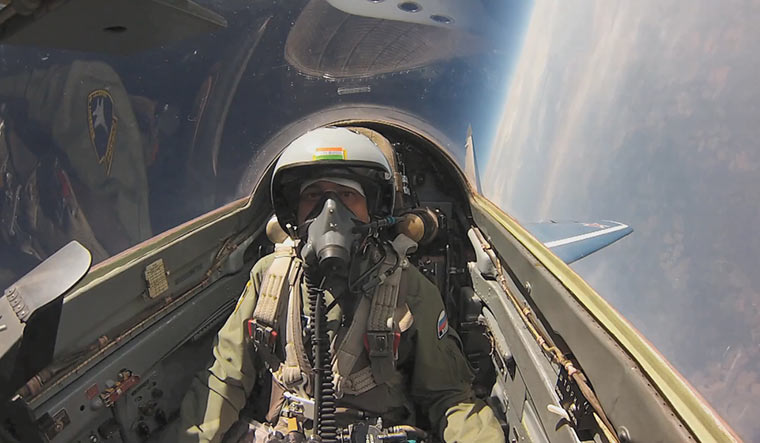 In his G-Suit in a MiG-29
In his G-Suit in a MiG-29
He said there were specialists on board to help the participants float in various poses. “I requested for the padmasana yoga posture,” he said. “It was a once-in-a-lifetime experience as we don’t have this facility in India for the common man.” On this flight, too, he carried the Indian flag and his mother’s photo.
Though the flight to the stratosphere and the zero-gravity flight were related to the space scientist’s profession, his trips are not limited to space-related adventures. The travel enthusiast has been to 167 countries and all seven continents. The 66-year-old, whose travels started in 1998, said that he gets rejuvenated by travel. At his villa, on the outskirts of Bengaluru, he has a whole set of jumbo passport booklets with visa stamps from all the countries he has travelled to.
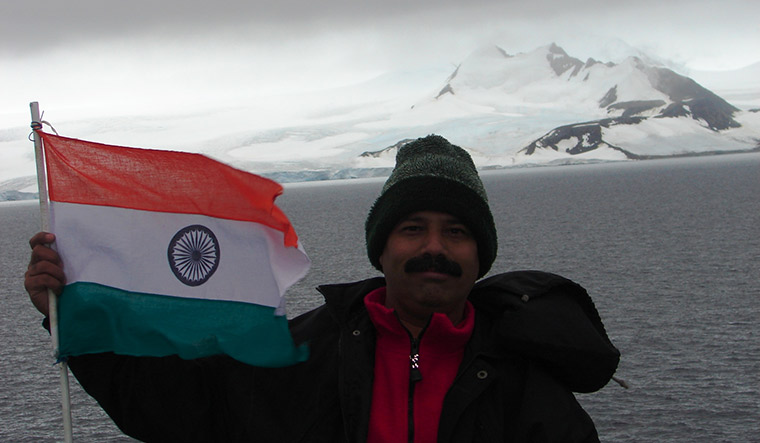 In Antarctica
In Antarctica
The trip to Antarctica in 2006 was when he completed visiting seven continents. He said that he had always been fascinated by icebergs and how big some of them are. He had not seen snowfall, snow-laden mountains and icebergs.
Though there are stations in Antarctica set up by the Indian government, he did not want to go through all the procedures and approvals which were required to visit them. “I wanted to travel as an individual,” he said. “I had options. From India, it takes 66 days, from New Zealand it takes 22 days and from South America, it takes 21 days. So, I decided to go through South America. I went to France, then to Brazil and from there I travelled in a ship to Antarctica. He said he remained on the ship, but enjoyed seeing seals and penguins and the imposing mass of ice. “We touched other islands, too,” he said.
Kumar retired from ISRO around six years ago, after more than 40 years of service. He was from a humble background and his parents were not well educated. But they did not let the same happen to their son. Kumar started his career at ISRO’s space application centre in Ahmedabad in 1978 and later shifted to Hassan, Karnataka. He worked on the Bhaskara and Apple communication satellites and was involved with the missions for more than 32 satellites, including INSAT, GSAT and IRNSS. As flight director, Kumar performed station-keeping orbit manoeuvres for satellites and also worked as a spacecraft power expert during satellite operations.
Kumar was involved in setting up the earth station for the GE Americom satellite and was deputed by ISRO to Canada for mission operations of INSAT-3B. He was also a fly-by coordinator and liaised with international space agencies during ISRO satellite missions.
After ISRO’s manned mission to space was cancelled in the mid-1980s, Kumar was highly disappointed. He had sleepless nights as he really wanted to go to space. But, he found a way to cope. “Since I could not go to space, I thought why not travel across the world and explore all the countries,” he said. “My wife encouraged me and that motivated me to move ahead in life. But, at that point it seemed difficult because of the huge amount of money required. Gradually, we started saving for the overseas trips. The pay commission money helped me save more.”
He added that since both he and his wife, Geetha, were scientists at ISRO, they got many benefits. “We got quarters and we used to get subsidised food in the office,” he said. “Besides, we lived in Hassan, where the cost of living was not as high as in the metros. My daughter’s schooling was in Kendriya Vidyalaya, which has a subsidised fee structure.” He added that he and his wife do not spend on luxury items or costly clothes. “Our aim is to save money and explore the world,” he added. “I accumulated leave and took them in one go for the travel.” Geetha has accompanied him on trips to 70 countries. His daughter, Raksha, who now works in Bengaluru for a UK-based company, has been to 53 countries.
A factor that has helped Kumar reduce the cost of travel is the fact that he carries ready-to-eat food packets from India. This is because he is a vegetarian and it is, at times, tough to find vegetarian food to his taste during travels. A favourite is the Gujarati flatbread thepla, as it can be stored for many days. He also carries a rice cooker. Moreover, he does not spend on expensive hotels, preferring home stays, budget hotels and rentals with a kitchen. He does not buy clothes, expensive artefacts and luxury items during the trips. As he reiterates, the trips are geared towards seeing, not buying.
His scientific temperament often takes over during his travels. He cited his visits to Africa. “I cherish my travels in Africa,” he said. “Everything is different. We have tall buildings here, there are tall trees in Africa. I like meeting people, understanding their culture, talking to them. Till date, I have had no problems while travelling. In Africa, for instance, I have lived in small huts. I came to know that North Africa’s landscape had many similarities with Mars. I got a first-hand feel of various things during my trip to North Africa, like rock formations, and different types of snakes.”
Kumar also has a keen interest in active volcanoes. Since India does not have any, he has travelled to see them, to countries such as Congo (Mount Nyiragongo), Vanuatu (Mount Yasur), Nicaragua (Masaya Volcano) and Guatemala (Pacaya).
Age has not diminished his enthusiasm. He went sky diving after retirement. When he gets time, he shares insights with students from NITs and IITs and other institutes and motivates them to become space scientists. He also wants to keep exploring the world. However, his next trip will be within India and he definitely will not have to pack theplas―he is planning a 10-day visit to Gujarat to explore the state fully.
“I am a firm believer of science and nature,” he said. “I do not believe that there is a next life, hence I want to experience every geographical aspect of mother earth. What I learnt in school, I wish to experience. I have experienced icebergs, the midnight sun, the northern lights, jungles of Africa and the Amazon, and the Coriolis effect at the equator.”
So, after travelling to the edge of space and the bottom of the ocean (in a submarine in Indonesia), and all seven continents, what was next? “I wish to complete the remaining few countries in the next few years,” he said.


